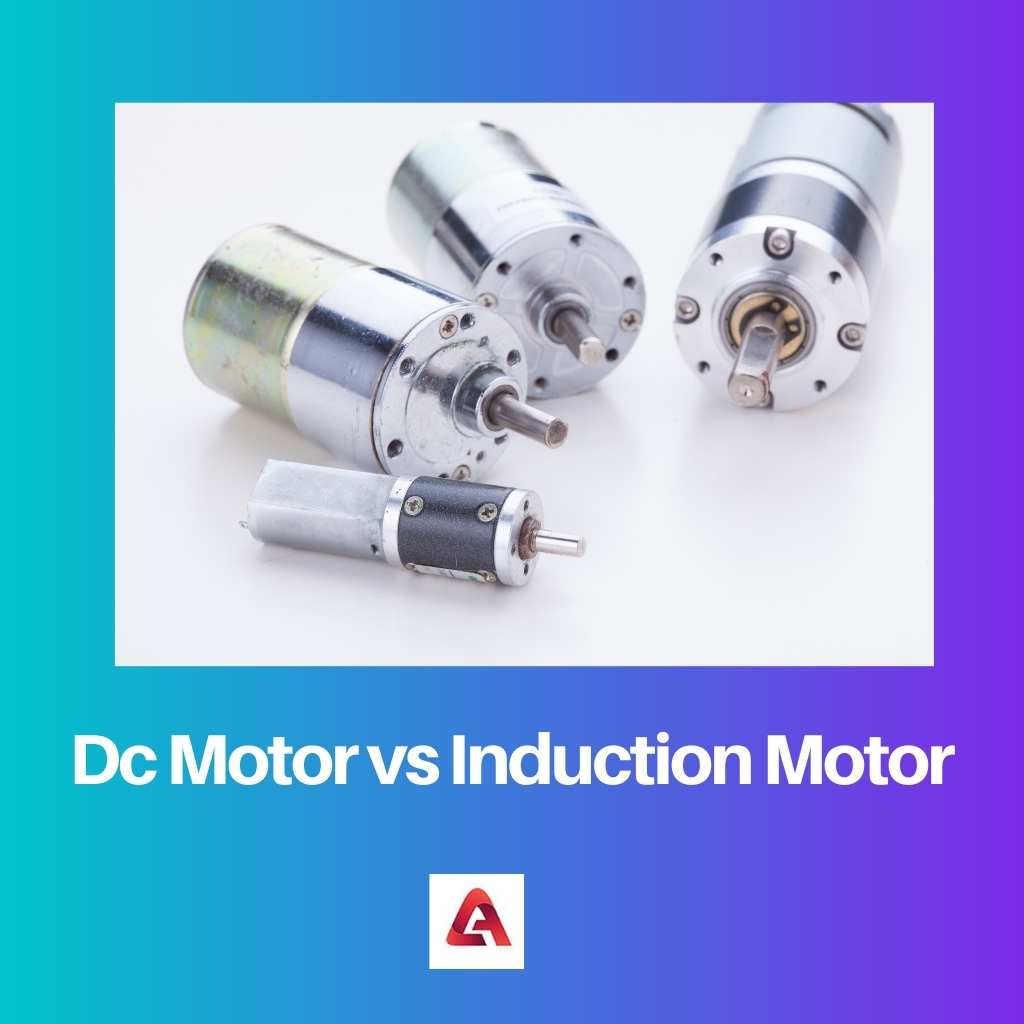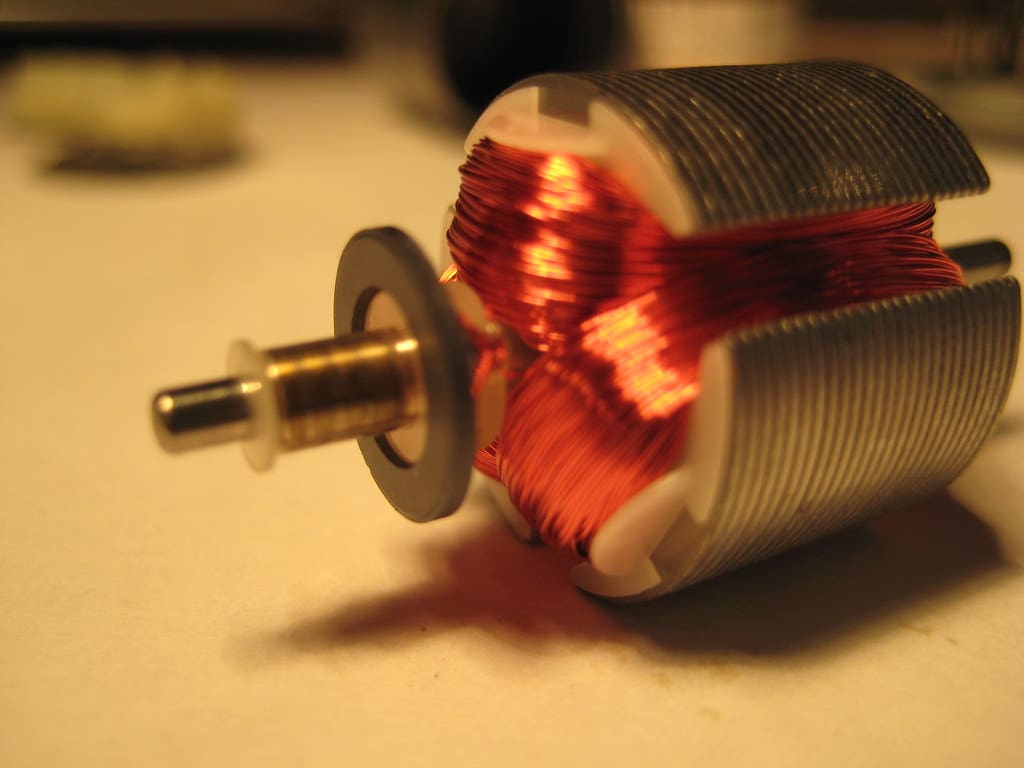The word “motor” simply refers to an electrical machine that converts electrical power into mechanical power. It aids in making something work through its force.
The magnetic field generates force inside the motor when it meets with direct (DC) and maybe even alternating (AC) electricity.
Motors may be found in a variety of businesses, organizations, and even homes. Motors are employed in a variety of applications, from toys to elevators, depending on their size and power.
DC & Induction(AC) motors are the two most common types of motors.
Key Takeaways
- DC motors require a direct current power source, while induction motors use alternating current.
- Induction motors exhibit greater efficiency and require less maintenance than DC motors.
- DC motors provide better speed control, whereas induction motors offer better torque capabilities.
DC Motor vs Induction Motor
A DC motor is a type of electric motor that operates on direct current (DC) electricity. It converts electrical energy into mechanical energy through the interaction between a magnetic field and current-carrying conductors. An induction motor is a type of alternating current (AC) electric motor that uses electromagnetic induction to convert electrical energy into mechanical energy.

The DC motor is a type of electric motor that converts electrical energy to mechanical energy. Its speed could be adjusted by adjusting the current in the winding.
They were frequently utilized due to their ability to obtain power from existing direct-current lighting power distribution systems. Crouzet, RS PRO, & Maxon are some well-known DC motor brands.
The fundamental purpose of an induction motor, known as an AC motor, is to transform electrical input signals into mechanical energy.
AC linear motors operate in the same way as rotational motors, with the exception that their components are organized in a straight line.
AC motors come in a variety of shapes and sizes, each with its own set of output capabilities and operating characteristics. Panasonic, ABB, & DKM AC motors are some well-known brands of AC motors.
Comparison Table
| Parameters of Comparison | Dc Motor | Induction Motor |
|---|---|---|
| Power | Direct Current | Alternating Current |
| Phase | Single Phase | Single/ Three phase |
| Repairing | Cheap | Costly |
| Costly | Shorter | Longer |
| Frequency(India) | 0 | 50HZ |
What is Dc Motor?
The DC motor, also known as a direct current motor, is a type of electric machine whose primary function is to convert electrical energy to mechanical energy.
Because this motor is based on DC, it runs on direct current electricity. It then turns this energy into mechanical rotational energy for the motor. The majority of DC motors use an internal mechanism to alter the direction of the current.
Because of their power and size differences, DC motors could be utilized in everything from little toys to massive machines like pull elevators.
The DC motor is indeed a part of the stator, which is a stationary component. And there’s an armature whose primary function is to rotate. As a result, the stator generates magnetic fields, which drive the armature in a rotating motion.
William Sturgeon invented the DC motor in 1832. Since many new appliances were produced based on DC motors, the creation of the DC motor helped significantly to redefine the face of the industry and, as a result, led to development.
Brushless, brushed, shunted, & series DC motors are the four major types of DC motors.
Every kind of DC motor does have its own set of benefits that are tailored to a certain application. There are a variety of gadgets on the market that make daily life easier.
Small DC motors can be found in a variety of household products and toys. Large DC motors have been utilized in industrial applications to brake and reverse.

What is Induction Motor?
A typical form of the motor is the induction motor, known as an alternating current motor. Since this motor has been based on AC, it uses alternating current to operate.
The primary goal of an induction motor would be to convert electrical energy into mechanical energy. As just a result, every current flowing through the circuit uses alternating current to generate mechanical energy.
Nikola Tesla developed the AC motor in 1887. Due to its convenience of operation, sturdiness, general affordability, & low production costs, AC motors are employed in industries, offices, and at home.
AC motors are used in clocks, audio turntables, disc drives, power drills, fans, and washing machines, among other appliances.
In AC motors, the flow around a circuit is reversed at regular intervals, or the voltage on an AC circuit changes periodically. An alternator is a device that assists AC motors in producing alternating current directions.
When energy travels through the rotor and spins around the stator, the alternator produces an electromagnetic field.
Squirrel cage, Brushless, AC motors, and others also are among the many varieties of AC motors available on the market. However, induction & synchronous AC motors are prevalent among them.
The induction motor has a lower speed than the synchronous motor, however, the synchronous motor’s speed remains constant regardless of the load.

Main Differences Between Dc Motor and Induction Motor
- When the motor’s speed is controlled externally, DC motors are preferred. Induction motors, on the other hand, are useful when a high level of power is required over a longer length of time.
- DC motors have a constant magnitude and only flow in one direction when it comes to amplitude and direction. Induction motors, on either hand, reverse the current regularly.
- DC motors’ speed can be changed by changing the armature’s winding current. Induction motors, on the other hand, can be controlled by changing the frequency of the current.
- The magnetism is not rotated in DC motors, but the armature is rotated. Induction motors, on the other hand, have rotating magnetic fields but no movement in the armatures.
- In DC motors, no external assistance is required to start any operation. Induction motors, on the other hand, require additional assistance or starting equipment including a capacitor to begin any effective operation.

- https://ieeexplore.ieee.org/abstract/document/4504799/?casa_token=lybx3-nhHiMAAAAA:mxtEedQrofA532ccj10eR2fvR1tkdV3wxCsY1IO6RnVyt2twkW2_TJvStTuiF3C-VziML_xKfVE
- https://ieeexplore.ieee.org/abstract/document/1435695?casa_token=CDUZ8l_MEvIAAAAA:r1gofW0ecA5_bz6k8gqBYfcloeFbcETMxvF9OAAlVJnfw8PuiOnBTC-XygB5rWoYMn5_JXzw4Pc
